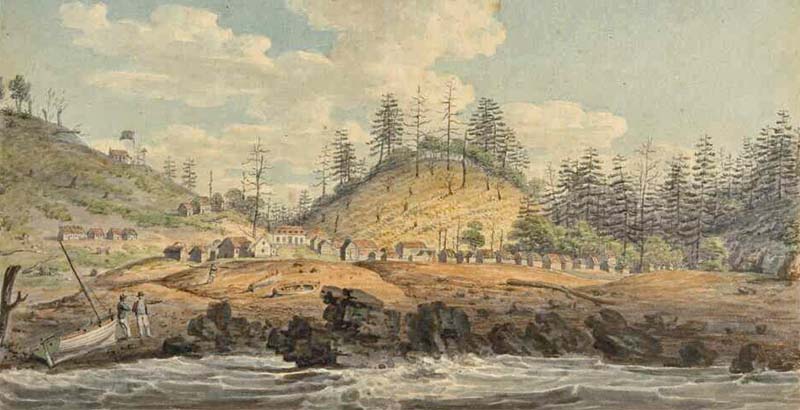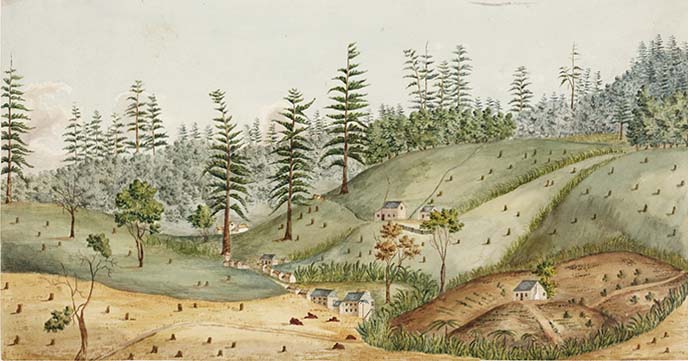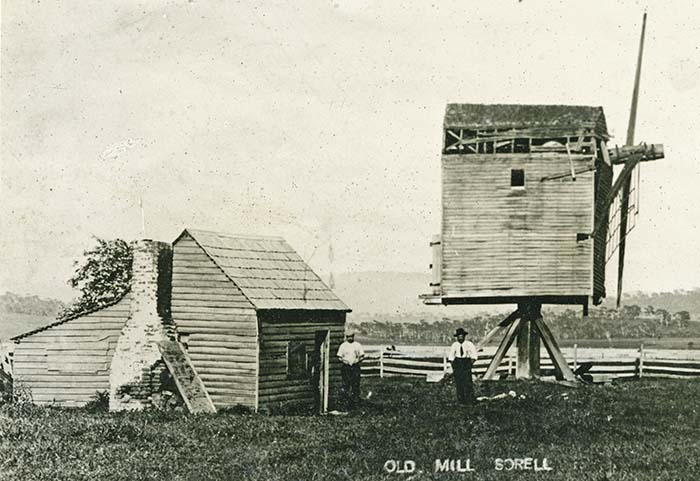
Robert Nash, carpenter and miller on Norfolk Island
1791 to 1814
Topics: Master-carpenter, colonist in First Settlement and Tasmania, Ann Hannaway, William Maum
Singleton Mills homepage > Norfolk Island Flour Milling Overview > Robert Nash in the First Settlement of Norfolk Island
Arrival and marriage
Robert Nash (1771-1819), a miller, was the son of a millwright in Kent, England. In 1790, he was convicted of theft and sentenced to transportation for life to New South Wales (NSW), Australia.
In 1791, Robert Nash was sent to Norfolk Island, an outpost of the main colony in NSW. He soon married another convict there, Ann Hannaway. The couple went on to have a large family together.

Above, a view of the First Settlement on Norfolk Island in about 1797. Watercolour by Edward Dayes. National Library of Australia.
A carpenter and miller on Norfolk Island
Like Nathaniel Lucas, Nash had learned carpentry skills prior to his conviction in England. On Norfolk Island, Nash proved to be a valued, industrious worker too. He was given a Conditional Pardon in 1796 and was appointed as a Master Carpenter of Norfolk Island in 1798.
Nash had arrived on Norfolk Island prior to the construction of the watermill in Arthur's Vale. So, it is possible that Nash, with his milling background, had assisted Lucas in the construction of this and later mills on Norfolk Island, although no documentation has been found to confirm this.
A decade later, Nash established his own watermill on Norfolk Island in about 1807. He said that it cost him nearly £300 to build. He also owned at least two pairs of millstones.[1]
Evacuation to Tasmania
Nash and his family were evacuated to Tasmania (then known as Van Diemen's Land) in 1808, because the British Government had decided to close the Norfolk Island settlement.
A personal letter written to Nash has remarkably survived from fellow-settler, William Maum (1780-1850), who had been evacuated to Tasmania on an earlier ship. In this letter, Maum conveyed a piece of intriguing advice to Nash from a Tasmanian official:
'He desires that you particularly bring down your Mill Stones and your Mill works, as he will engage to find you a sufficiency of water etc. – bring with you hoes etc. and all other tools as they are remarkably scarce, and you may expect a good house to receive you, on your arrival, which is here a matter of great consequence.' [2]
If Nash succeeded in following the official's advice, this would be another case of Norfolk Island millstones being shipped to Australia in the early 1800s.
An unwilling evacuee
Nash was extremely reluctant to leave Norfolk Island. He, his wife, Ann, and their children had lived on Norfolk Island for 18 years. They had a comfortable home, and owned land, stock, and buildings, in addition to their new watermill. However, Bligh, the Governor of NSW, had warned the settlers that, if necessary, they would be evacuated by force.[3]

Above, a group of First Settlement settlers farming the fertile valley at Queensborough in southwestern Norfolk Island. Immense efforts had been invested by the settlers in establishing farms like this throughout the island. A watercolour, ca. 1804, by John Eyre, possibly based on an earlier drawing by William Neate Chapman. State Library of NSW.
When the time came for Nash to board the ship that would transport him from Norfolk Island, in September 1808, he and a fellow settler fled into the bush. However, crew members from the ship hunted them down. Finally, both men were unceremoniously dumped on the deck of the ship and the ship departed.[4]
Robert Nash's flour mills in Tasmania
Robert Nash and his family settled in Tasmania. There he built two watermills, one of which was unfortunately destroyed by riverine flooding.[5]
Then Nash moved to Pitt Water (Sorell district), Tasmania, where, in 1817, he built a well-known post-mill, said to be the first windmill in the settlement.[6]

Above, this photograph shows a very old post-mill type windmill, that was built at Sorell in Tasmania. It is possible that this was the mill constructed by Robert Nash when he came to live in Tasmania, following his time on Norfolk Island. Photograph from the Tasmanian Archives, Libraries Tasmania.
REFERENCES
1. Robert Nash Memorial to Governor Macquarie, 21 May 1810, Colonial Secretary's Papers, 1788-1856. Archived at ancestry.com.au
2. William Maum letter, Hobart Town, 18 January 1808. Transcription viewed at: https://www.tasfamily.net.au/~schafferi/index.php?file=kop84.php
3. Phelps, Narissa (2022) The lowest ebb in life: individual responses to the forced evacuation of Norfolk Island's first settlement, 1803-1814. Journal of Australian Colonial History, 24: 1-23, page 10.
4. The Mercury (Hobart, Tasmania), 2 April 1880.
5. https://www.wikitree.com/wiki/Nash-1007
6. The Hobart Town Gazette and Southern Reporter, 8 February 1817.
Read More About Norfolk Island's Flour Mills
•• Overview •• First Settlement Flour Mills •• Second Settlement Flour Mills •• Nathaniel Lucas •• Robert Nash •• Norfolk Island Millstones ••